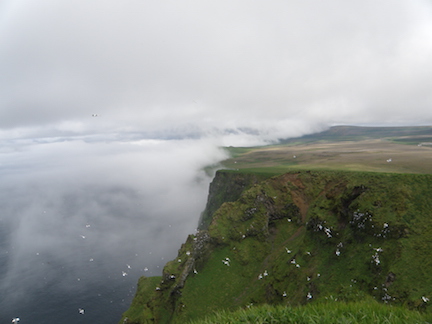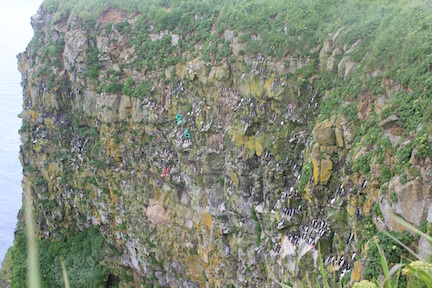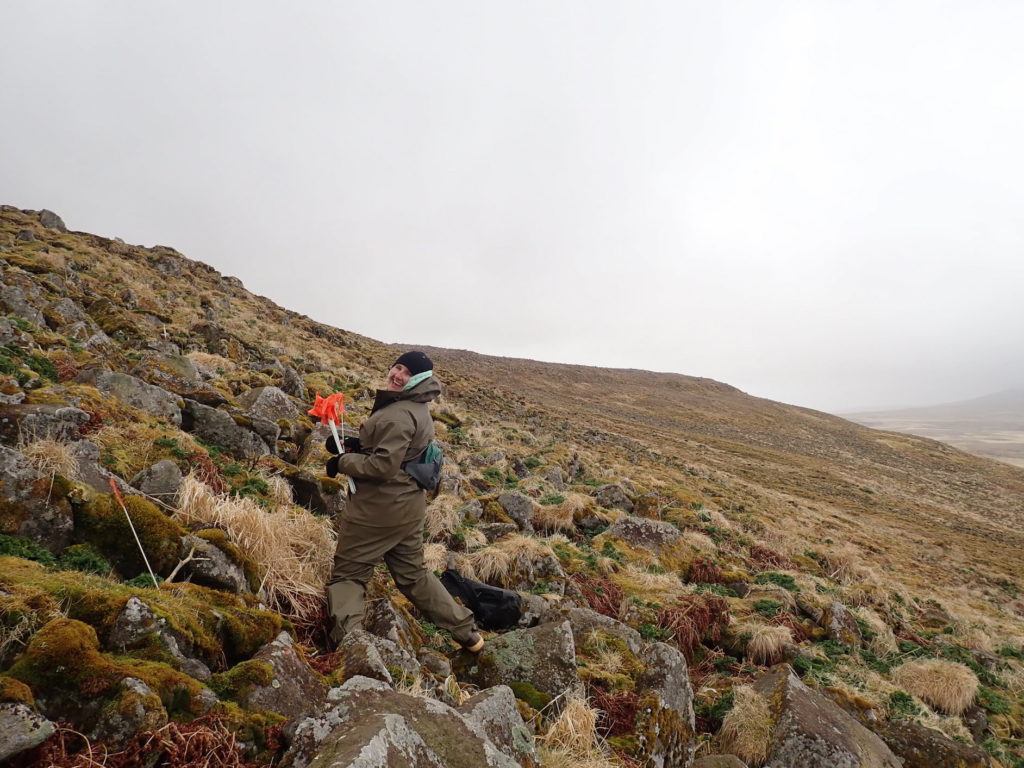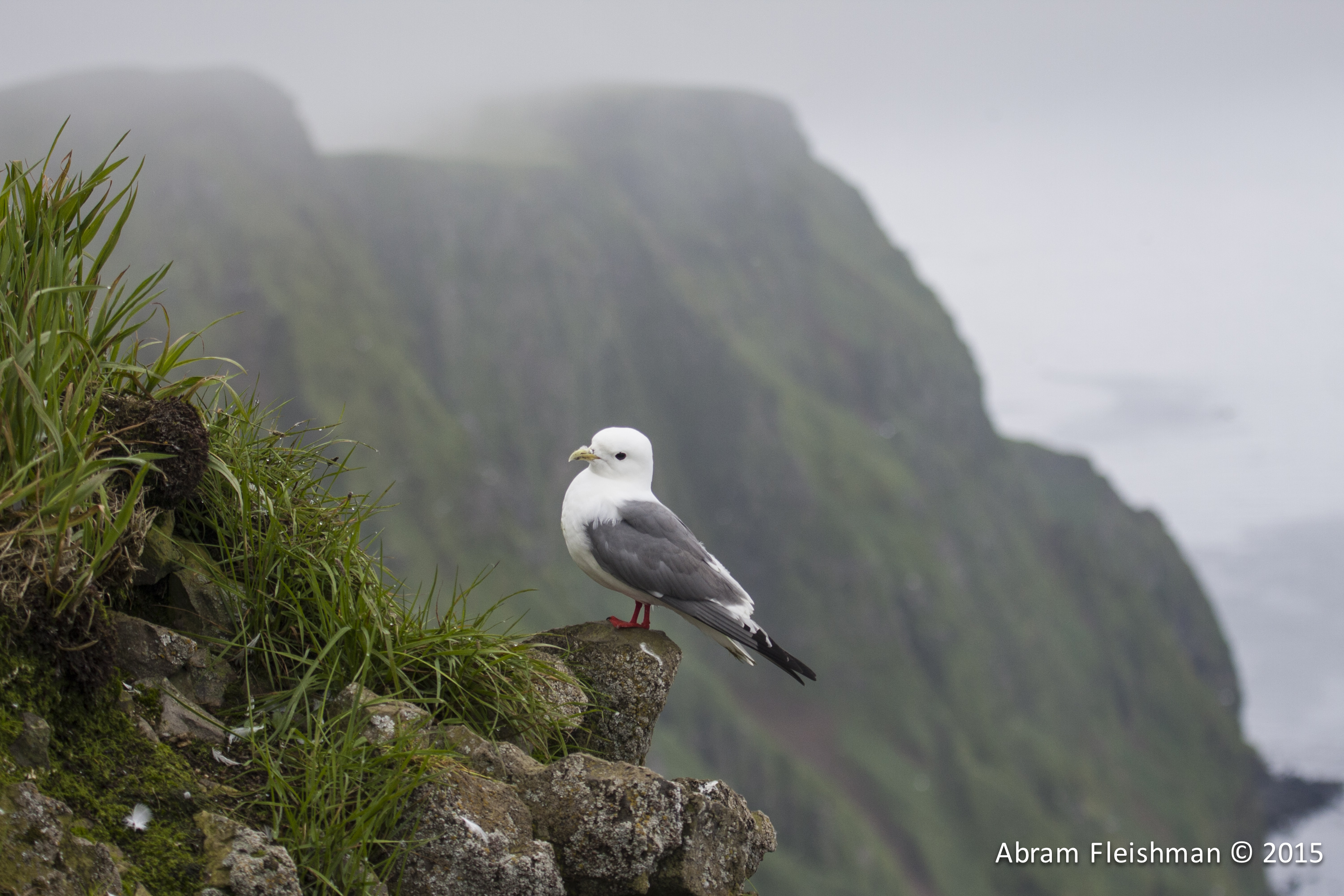Sarah Guitart was part of the Alaska Maritime National Wildlife Refuge’s field team working on St. George Island this past summer. Many thanks for sharing this report, Sarah:
Another wonderful summer on St. George has come to a close! We’ve had a challenging but rewarding season. We battled fog, high winds and cancelled flights, all for the opportunity to spend a few months working on a beautiful island with some truly special seabirds.

Laney with a banded Least Auklet
This season we focused primarily on the productivity of 6 seabird species: Red-legged Kittiwakes, Black-legged Kittiwakes, Least Auklets, Thick-billed Murres, Common Murres and Red-faced Cormorants. Productivity is measured by the success or failure of each nesting attempt. For kittiwakes and cormorants, a nesting attempt is simply a nest! Murres and auklets, on the other hand, don’t build nests, so we begin monitoring them when we see a bird incubating an egg. We’ll watch each nest as it changes from a nest, to a nest with eggs, to a nest with chicks, and finally until the chicks fly from the nest. A successful nest is one that has chicks old enough to survive on their own. We check our nests every 3-4 days in order to keep track of how it’s progressing and to figure out at what point a nest fails.
Our birds did not fare as well as we would have liked this summer. Kittiwakes did not begin building nests until around mid-June. Typically we see kittiwake nest building attempts when we first arrive in mid-May. For a while, it felt like kittiwakes weren’t going to attempt a breeding season at all! Luckily we had some nests with eggs in late June. Ultimately, both kittiwake species had near complete reproductive failure for the fourth year in a row. Black-legged Kittiwakes did not have any eggs hatch and Red-legged Kittiwakes only had one nest with a chick that survived long enough to be considered a fledged chick.
 Kittiwakes fly around High Bluffs as the fog rolls in
Kittiwakes fly around High Bluffs as the fog rolls in
Murres did better on paper than the kittiwakes, but even they were on the later side. Murres nest very close together on the cliffs, so hundreds and hundreds of murres can be nesting on one cliff face. We managed to get a large sample size of murre nests, but we noticed that the majority of murres on the cliffs simply weren’t laying eggs. A little less than half of our nest sites had a successful chick, but quite a few of those chicks were still on the cliffs when we left. We even extended our time in the field just to make sure we had seen them for enough days to consider them fledged!

Cliffs full of murres
Least Auklets crevices were difficult to find this season. Least Auklets nest tucked away into rocky crevices. In a usual season, we try to find at least 70 active crevices. There are over 150 marked crevices that have, in the recent past, housed Least Auklets. This season, however, we were only able to find 24 active crevices. What’s more, when we tried to search the colony for new crevices, we could only find four. That being said, we could hear adults and then chicks throughout the colony. We even saw many adults flying with food for chicks! It’s not known if the Least Auklets are nesting deeper in the rocks or if they’re leaving the colony in search of better habitat. What we do know from this season is that they didn’t have much reproductive success that we could see.

Searching for least auklet nests
In addition to monitoring crevices, we also check nest boxes that were put in place for Least Auklets to use as nest sites. They were in need of some repair this season so Ann, Thomas and Maurice helped spruce up the boxes. They even built up a portion of our rocky blind that we hide behind to read Least Auklet bands! Thomas and Maurice were a huge help with our biological work and we can’t thank them enough!
All in all, it was a great season on St. George. While the lack of cute fuzzy chicks may seem sad, collecting biological data on poor productivity years is extremely important. Biologists use this data to determine if these low productivity years are simply part of a regular cycle or if they are a sign that something is changing. Seabirds are an amazing resource and they can tell researchers a lot about the marine environment. The cool challenge for researchers is to figure out how to ask the questions!

